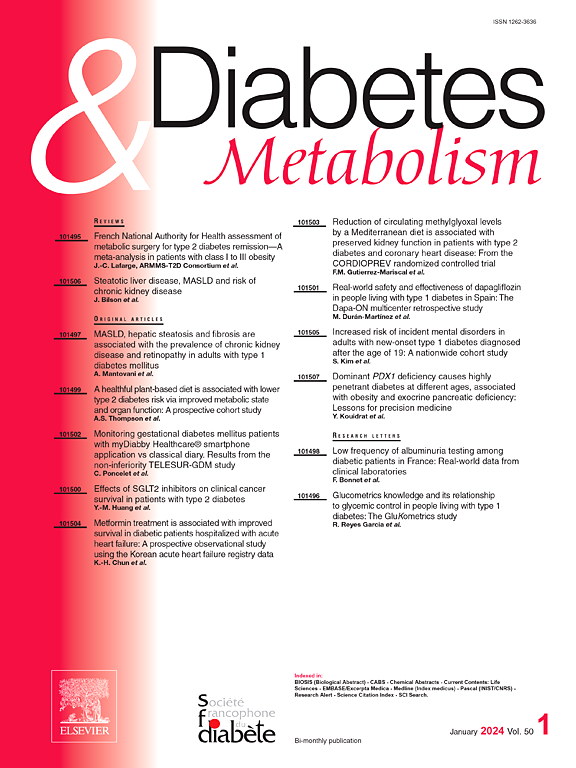Diabetes prevalence, awareness, and control in the United States, 2017-2023
IF 4.7
2区 医学
Q1 ENDOCRINOLOGY & METABOLISM
引用次数: 0
Abstract
Introduction
We compared diabetes prevalence, awareness, and control pre versus post the Covid-19 pandemic.
Methods
This was a cross-sectional analysis of the U.S. National Health and Nutrition Examination Surveys pre (2017–2020) and post (2021–2023) the pandemic. We included all non-pregnant adults (aged ≥ 20 years) who had undergone biomedical testing. Diagnosed and undiagnosed diabetes was defined as self-reported diabetes and no self-reported diabetes with HbA1c >6.5 % or fasting plasma glucose ≥126 mg/dL, respectively. Among diagnosed diabetes, we estimated proportions achieving glycemic (HbA1c < 7.0 %), blood pressure (< 130/80 mmHg), and cholesterol control (non-high-density lipoprotein < 130mg/dl), and use of blood pressure and lipid lowering medications.
Results
The prevalence of total diabetes, diagnosed diabetes, undiagnosed diabetes, and proportion of diabetes that was undiagnosed remained stable between pre and post pandemic periods: from 16.2 % [95 %CI: 14.3–18.1] to 15.8 % [13.7–17.9], from 11.7 % [10.1–13.2] to 11.3 % [9.4–13.2], from 4.6 % [3.8–5.3]) to 4.5 % [3.4–5.6]), and from 28.1 % [24.3–31.8] to 28.4 % [21.9–35.0], respectively. Among those with diagnosed diabetes, glycemia, blood pressure, lipid control, and use of blood pressure or lipid medication did not significantly change.
Conclusions
Between 2017–2020 and 2021–2023, there were no significant changes in diabetes prevalence, awareness, and control in the U.S. population.
2017-2023年美国糖尿病患病率、认知和控制
我们比较了Covid-19大流行前后的糖尿病患病率、意识和控制。方法:本研究是对美国全国健康和营养调查(2017-2020年)和(2021-2023年)大流行前后的横断面分析。我们纳入了所有接受过生物医学检测的未怀孕成人(年龄≥20岁)。确诊和未确诊糖尿病分别定义为HbA1c≥6.5%或空腹血糖≥126 mg/dL的自我报告糖尿病和无自我报告糖尿病。在确诊的糖尿病患者中,我们估计了达到血糖(HbA1c <;7.0%),血压(<;130/80 mmHg)和胆固醇控制(非高密度脂蛋白<;130毫克/分升),并使用降血压和降脂药物。结果总糖尿病、确诊糖尿病、未确诊糖尿病和未确诊糖尿病的患病率在大流行前后保持稳定,分别为16.2% [95% CI: 14.3-18.1] ~ 15.8%[13.7-17.9]、11.7%[10.1-13.2]~ 11.3%[9.4-13.2]、4.6%[3.8-5.3]~ 4.5%[3.4-5.6]、28.1%[24.3-31.8]~ 28.4%[21.9-35.0]。在诊断为糖尿病的患者中,血糖、血压、脂质控制和使用血压或脂质药物没有显著变化。在2017-2020年和2021-2023年期间,美国人口中糖尿病患病率、认知和控制没有显著变化。
本文章由计算机程序翻译,如有差异,请以英文原文为准。
求助全文
约1分钟内获得全文
求助全文
来源期刊

Diabetes & metabolism
医学-内分泌学与代谢
CiteScore
12.00
自引率
4.20%
发文量
86
审稿时长
13 days
期刊介绍:
A high quality scientific journal with an international readership
Official publication of the SFD, Diabetes & Metabolism, publishes high-quality papers by leading teams, forming a close link between hospital and research units. Diabetes & Metabolism is published in English language and is indexed in all major databases with its impact factor constantly progressing.
Diabetes & Metabolism contains original articles, short reports and comprehensive reviews.
 求助内容:
求助内容: 应助结果提醒方式:
应助结果提醒方式:


